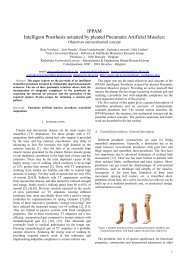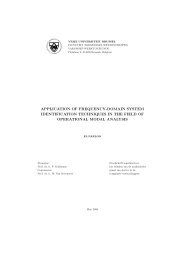VRIJE UNIVERSITEIT BRUSSEL Acoustics - the Dept. of ...
VRIJE UNIVERSITEIT BRUSSEL Acoustics - the Dept. of ...
VRIJE UNIVERSITEIT BRUSSEL Acoustics - the Dept. of ...
Create successful ePaper yourself
Turn your PDF publications into a flip-book with our unique Google optimized e-Paper software.
46 CHAPTER 3. MEASURING SOUNDFigure 3.12: pistonphone for <strong>the</strong> calibration <strong>of</strong> a microphone. Source:Bruël&Kjær.3.8 Quantitative parameters3.8.1 The equivalent sound pressure levelTo characterize sound that highly varies in time, one introduces <strong>the</strong> equivalentsound level. A constant sound at this level contains <strong>the</strong> same acousticenergy as <strong>the</strong> highly varied sound. The equivalent sound level is obtained byaveraging <strong>the</strong> average quadratic sound pressure over <strong>the</strong> desired time intervaland converting it again to dB. From <strong>the</strong> definition <strong>of</strong> <strong>the</strong> sound pressure levelone obtains:this gives :p 2 rmsp 2 0( ) p2L eq = 10log rmsp 2 0= 10 Lp/10 (3.2)( 1= 10logT∫ T0)10 Lp/10 dt(3.3)With L eq <strong>the</strong> equivalent sound level (dBA), p 2 rms <strong>the</strong> time average <strong>of</strong> <strong>the</strong>average quadratic sound pressure and T <strong>the</strong> time over which <strong>the</strong> averaging
















